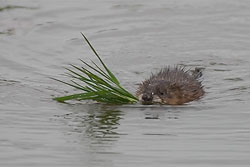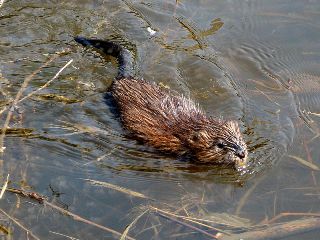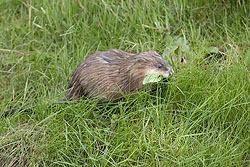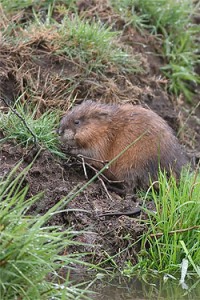
Adaptation:
It's a changing world
Muskrats have adapted in several
ways to be able to survive in their aquatic habitat. They are
experts when it comes to swimming. Muskrats are able to maneuver
around in the water very quickly and with ease by using their
webbed hind feet to propel themselves and their tails
 to aid in
steering, as seen in several videos in my
Photo Gallery. Another interesting adaptation is their
ability to swim both forwards and backwards which also enhances
their mobility in their aquatic habitat. They also possess an
amazing ability that makes it possible for them live well in
their niche. This adaptation gives them the ability to “breathe”
underwater for up to about fifteen minutes at a time. Their
bodies have the ability to transport oxygen from other tissues
in their bodies to the rest of their body. They also can reduce
the amount of oxygen their body needs while underwater by just
relaxing. This method works well because when they are at rest
or not moving their body does not require as much oxygen to be
transported to contracting muscles.
to aid in
steering, as seen in several videos in my
Photo Gallery. Another interesting adaptation is their
ability to swim both forwards and backwards which also enhances
their mobility in their aquatic habitat. They also possess an
amazing ability that makes it possible for them live well in
their niche. This adaptation gives them the ability to “breathe”
underwater for up to about fifteen minutes at a time. Their
bodies have the ability to transport oxygen from other tissues
in their bodies to the rest of their body. They also can reduce
the amount of oxygen their body needs while underwater by just
relaxing. This method works well because when they are at rest
or not moving their body does not require as much oxygen to be
transported to contracting muscles.

Another significant adaptation muskrats have is the
ability to respond quickly when they feel threatened and can’t
easily evade the threat. They are excellent burrowers and can
dig a hole in the soft soil near the edge of the water and
sometimes end up creating a short tunnel that opens up to the
soil just above the water line. If they are practiced in this
evasion technique they can even create a cloud of mud under the
water to camouflage their exit by kicking up enough mud as they
are burrowing. This enables them to make a quick escape and also
leave their threat, like a predator, confused as to where they
went.
Muskrats have also gained the ability to gnaw and chew
underwater. Their incisors are placed in front of their cheeks,
which enables them to eat or cut up the submerged roots and
stems of
 vegetation found in their habitat, some of which are
listed on my Nutrition page. All of
these adaptations allow muskrats to forage during the winter
which means that they don’t have to store food during the summer
and fall months for winter and early spring. During the winter
when ice covers everything muskrats are even able to break
through the ice if it is thin enough, and surface to look for food
during hard times. They are a very hardy species, however and can
live in very undesirable conditions.
vegetation found in their habitat, some of which are
listed on my Nutrition page. All of
these adaptations allow muskrats to forage during the winter
which means that they don’t have to store food during the summer
and fall months for winter and early spring. During the winter
when ice covers everything muskrats are even able to break
through the ice if it is thin enough, and surface to look for food
during hard times. They are a very hardy species, however and can
live in very undesirable conditions.

During the winter months and when ice is present,
muskrats will share their lodge with several other muskrats
including their growing pups and possibly their mate or other
family members. The air quality inside of the lodge can become quite
disgusting because of the lack of ventilation and the increased
amount of time spent inside it compared to the months where ice
is not present. However this is not a problem for muskrats and
it does not appear to have an effect on their well being. Their
ability to adapt to many different situations also makes it
possible for them live in a variety of habitats. All of these
adaptations have allowed muskrats to prosper for so long, even
in seemingly undesirable habitats. See my
Habitat and Geography page to learn more about the different
types of habitats muskrats can occupy!
Click here to go to the Nutrition
page!
Click here to go home!